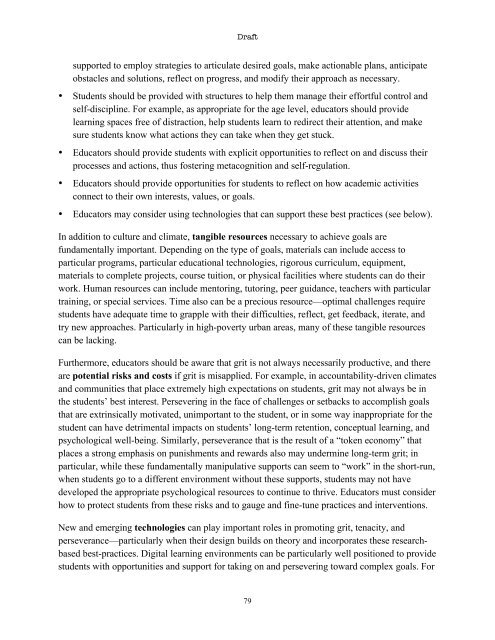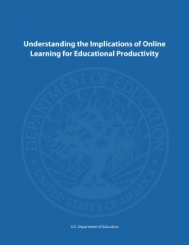Promoting Grit, Tenacity, and Perseverance - U.S. Department of ...
Promoting Grit, Tenacity, and Perseverance - U.S. Department of ...
Promoting Grit, Tenacity, and Perseverance - U.S. Department of ...
Create successful ePaper yourself
Turn your PDF publications into a flip-book with our unique Google optimized e-Paper software.
Draft<br />
supported to employ strategies to articulate desired goals, make actionable plans, anticipate<br />
obstacles <strong>and</strong> solutions, reflect on progress, <strong>and</strong> modify their approach as necessary.<br />
• Students should be provided with structures to help them manage their effortful control <strong>and</strong><br />
self-discipline. For example, as appropriate for the age level, educators should provide<br />
learning spaces free <strong>of</strong> distraction, help students learn to redirect their attention, <strong>and</strong> make<br />
sure students know what actions they can take when they get stuck.<br />
• Educators should provide students with explicit opportunities to reflect on <strong>and</strong> discuss their<br />
processes <strong>and</strong> actions, thus fostering metacognition <strong>and</strong> self-regulation.<br />
• Educators should provide opportunities for students to reflect on how academic activities<br />
connect to their own interests, values, or goals.<br />
• Educators may consider using technologies that can support these best practices (see below).<br />
In addition to culture <strong>and</strong> climate, tangible resources necessary to achieve goals are<br />
fundamentally important. Depending on the type <strong>of</strong> goals, materials can include access to<br />
particular programs, particular educational technologies, rigorous curriculum, equipment,<br />
materials to complete projects, course tuition, or physical facilities where students can do their<br />
work. Human resources can include mentoring, tutoring, peer guidance, teachers with particular<br />
training, or special services. Time also can be a precious resource—optimal challenges require<br />
students have adequate time to grapple with their difficulties, reflect, get feedback, iterate, <strong>and</strong><br />
try new approaches. Particularly in high-poverty urban areas, many <strong>of</strong> these tangible resources<br />
can be lacking.<br />
Furthermore, educators should be aware that grit is not always necessarily productive, <strong>and</strong> there<br />
are potential risks <strong>and</strong> costs if grit is misapplied. For example, in accountability-driven climates<br />
<strong>and</strong> communities that place extremely high expectations on students, grit may not always be in<br />
the students’ best interest. Persevering in the face <strong>of</strong> challenges or setbacks to accomplish goals<br />
that are extrinsically motivated, unimportant to the student, or in some way inappropriate for the<br />
student can have detrimental impacts on students’ long-term retention, conceptual learning, <strong>and</strong><br />
psychological well-being. Similarly, perseverance that is the result <strong>of</strong> a “token economy” that<br />
places a strong emphasis on punishments <strong>and</strong> rewards also may undermine long-term grit; in<br />
particular, while these fundamentally manipulative supports can seem to “work” in the short-run,<br />
when students go to a different environment without these supports, students may not have<br />
developed the appropriate psychological resources to continue to thrive. Educators must consider<br />
how to protect students from these risks <strong>and</strong> to gauge <strong>and</strong> fine-tune practices <strong>and</strong> interventions.<br />
New <strong>and</strong> emerging technologies can play important roles in promoting grit, tenacity, <strong>and</strong><br />
perseverance—particularly when their design builds on theory <strong>and</strong> incorporates these researchbased<br />
best-practices. Digital learning environments can be particularly well positioned to provide<br />
students with opportunities <strong>and</strong> support for taking on <strong>and</strong> persevering toward complex goals. For<br />
79
















